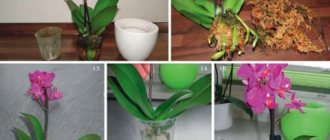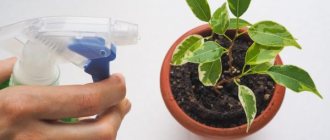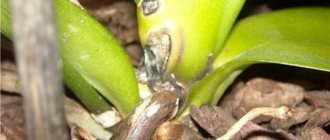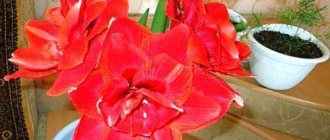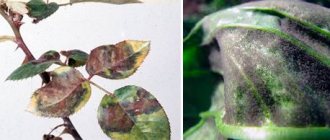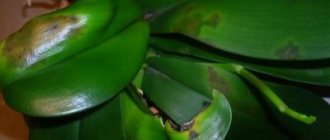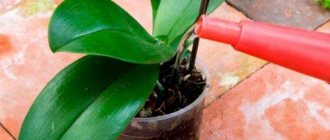Aphids on violets grow on all parts of plants, but prefer young leaves for habitat. Insects are small in size - about 2 mm. They are easy to manually remove and crush if the affected area is not too extensive.
Aphids reproduce catastrophically quickly: every 2 weeks, 1 female lays up to 150 eggs. Therefore, measures to combat parasites must be taken immediately.
Reasons for appearance
Aphids are natural inhabitants of the natural environment. It attacks violet leaves, preferring the inner side. The stems and flowers of plants are not left unattended. Numerous small insects, not exceeding two millimeters in length, cling to the flowers, feeding on their juice.
The appearance of these insects on violets does not occur without a reason, and is associated with the growing conditions of the crops. Insects appear on flowers growing in open ground in the garden due to the following circumstances:
- improper agricultural technology - untimely and poor-quality processing of crops, lack of care;
- aggressive environment in the growth zone - disruption of the ecological system, the spread of ants that carry aphids and contribute to their reproduction.
Pests, along with garden flowers, affect indoor flowers. Insects are not embarrassed by the limited number of objects of attack and the closed environment.
It is difficult to completely eradicate aphids in the garden. The gardener needs to regularly check the plants and take preventive measures to prevent the spread of pests. But in the situation with indoor flowers, aphids are not difficult to destroy completely and irrevocably.
Routes of infection
Infection with aphids occurs in the following ways:
- natural distribution of insects during the process of reproduction and dispersal. Pests migrate from surrounding crops - winged females fly from neighboring gardens, laying eggs;
- insects are brought by gardeners on seedlings of other plants planted on the site;
- with brought soil containing deposited larvae;
- through ants that spread aphids and increase the number of insects. Ants feed on the sticky sweet secretion secreted by aphids, so they treat it like a pet, transferring it to free plants and protecting it from the encroachments of competitors.
Pests are able to penetrate the closed ecosystem of indoor crops with a new flower when replacing the soil. The massive reproduction of aphids makes it one of the most dangerous pests for garden and indoor plants.
What types of indoor plants are most often affected by aphids?
Aphids can get nutrients from almost any plant, but there are some that this pest is especially fond of. The favorite delicacy of aphids among indoor plants are:
- roses;
- orchids;
- hyacinths;
- fuchsia;
- chrysanthemums;
- hibiscus.
Aphids on houseplants.
Symptoms
Even a novice gardener can easily recognize an infestation. The appearance of aphids can be recognized by the following characteristic signs:
- general wilting of the plant;
- numerous white, black or green tiny dots on the inside and then the outside of leaves, stems, buds;
- sticky liquid resembling sweet dew and covering the surface of the flower - subsequently a sooty fungus settles in these areas of the plant;
- tiny white scales remaining from hatched larvae;
- leaves curl, darken, become limp;
- the upper young shoots become deformed and dry out;
- the flowers take on ugly shapes, the violet stops throwing out new buds.
In addition to the direct harm associated with the loss of internal juices by the plant, aphid infestation threatens with the following unpleasant consequences:
- In the process of life, insects secrete a sticky enzyme that promotes the development of fungal diseases;
- attracting other pests - ants, mites;
- the occurrence of viral diseases in horticultural crops.
In case of severe infection, the plant stops blooming, withers, and after a few days it dies if the owner does not take emergency measures to combat the scourge.
Whitefly
A whitefly is a small insect with white wings that look like a small fly. Their larvae have the shape of very small grains. They appear when the room is almost not ventilated, and the atmosphere in the room is humid and warm.
The biggest threat is not the whiteflies themselves, but their larvae, as they suck the juice from the leaves. Also, the larvae secrete a sticky mixture, which promotes the development of fungus on young violet leaves. In turn, sooty fungus causes the plant to stop sprouting. Other signs of whitefly damage to violets are loss of decorativeness, as well as curling and wilting of leaves. Whiteflies promote the proliferation of bacterial diseases.
To combat this violet pest, you need to spray the plant regularly, once every 3 days, with permethrin-containing preparations. It is necessary to wash the plant before each spraying, paying special attention to the underside of the leaf. Also, systemic insecticides are very effective, but they must be used several times at intervals of 10 days.
How to fight at home?
The effectiveness of measures depends on the timeliness of the treatment and the extent of the infection. It is important to carefully and regularly inspect crops so that you can begin to fight at the first sign of pests.
Control methods are selected taking into account the growing conditions of violets. Some chemicals are not suitable for indoor flowers due to their high toxicity, which is dangerous for people in confined spaces. At the initial stage or as a preventive measure, folk remedies will help, but they will be powerless when pests spread. Considering that aphids are extremely fertile, when they appear on violets, there is a real threat to the rest of the plants in the garden or on the common windowsill in the room.
Learn more about how to fight aphids on violets at home.
Mechanical removal
If pests are detected, and the infestation has not yet become widespread, aphids can be removed mechanically:
- insects are collected by hand;
- the affected shoots break off;
- for indoor flowers - the leaves are washed with a warm soapy solution, the plant is dried in a warm place.
When the aphids are removed, the plant and surrounding soil are treated using special products.
An alternative way to remove pests is to attract natural enemies of aphids. This insect is present in the diet of ladybugs, hoverflies, some species of wasps, and birds. Planted fruit bushes and spicy varieties of herbs will help the gardener attract them.
Use of biological products
The means offered by modern industry for the control and prevention of aphids are divided into two groups:
- biological complexes - preparations created on the basis of natural components that repel and destroy pests;
- chemical compounds – insecticides of artificial origin.
Treatment with celandine
You can use a plant such as celandine. The way to use it is as follows:
- Flowering celandine is collected in the amount of 300 g raw or 100 g dry;
- pour a liter of water over the grass;
- leave for 36 hours, you can boil for half an hour;
- Spray the affected leaves with the resulting solution.
Celandine in the form of a tincture or decoction helps against aphids
Plant prevention
Reasonable prevention will prevent the appearance and reproduction of aphids on violets. The gardener will prevent infection by applying the following preventive measures:
- regular inspection of violets and other plants for the presence of pests;
- removing dried shoots and lower leaves from which aphids spread to the rest of the flower;
- combating ants that carry pests;
- planting violets on fertilized soil, in lighted and ventilated places;
- for indoor crops - do not place cut flowers brought from outside nearby; keep newly acquired plants separately for a certain time to control the absence of infection.
Careful care and adherence to agrotechnical practices will ensure the health and normal development of plants. If aphids appear, the infestation will be detected at an early stage, and adequate measures will be taken in time.
Introduction
And even if all these conditions are met, various diseases of violets or microscopic pests may appear completely unexpectedly.
To successfully cure plants, you need to learn to distinguish between non-infectious and infectious diseases of violets. So, if you notice that the leaves of a violet are turning yellow, there is no point in stocking up on fungicides. A constant lack of moisture, a lack of important nutrients, increased or decreased acidity of the soil, direct sunlight and shading are the main reasons why violet leaves turn yellow. Accordingly, eliminating the listed unfavorable factors will help improve the condition of the flower.
To successfully cure plants, you need to learn to distinguish between non-infectious and infectious diseases of violets
Infectious diseases of violets caused by fungi, viruses and bacteria are dangerous because they very quickly infect other plants if they are not eliminated in time. Let's consider common diseases of violets and pests that are most often found on these delicate flowers.
Aphids on violets: how to fight at home?
Aphids are insect pests of which there are more than 4,000 species. They differ in appearance and color. Exist:
- red;
- green;
- black;
- white and other types of aphids.
Various types of aphids.
Size no more than 5-7 mm. The female is mostly wingless, while the male has wings.
Detection method
Aphids settle in large colonies , which makes it possible to quickly recognize them. They move slowly and prefer to settle on the underside of leaves or young shoots . The females of these pests are very fertile. Up to 20-25 eggs are laid per day and those living on the plant do not require fertilization.
About 1000 different species can be found on the European continent. They all prefer warmth and moisture. On indoor violets you can find:
- house aphid . There are several subspecies that have different colors. Red, white black and green. The latter is found on Saintpaulias;
- mealy aphid . The parasite is cream-colored, with bristles on the sides. A distinctive feature is a powdery coating on the body, hence the name.
What harm does it cause?
Due to its huge numbers, aphids are capable of causing irreparable damage to a plant in a short period of time.
It sucks the juices out of the violet, while covering the surface with sticky juice, which prevents the penetration of oxygen. It also promotes the spread of sooty fungus, which can cause plant death.
Photos of dangerous pests of violets. Effective Treatments
Beginning of May - end of September - during these months you need to pay special attention to caring for violets.
Along with street dust and poplar fluff, insects that like to feast on delicate leaves and flowers can get onto the plant.
You can bring these insects into your apartment along with wildflowers, fruits and vegetables from the garden, as well as on new violets from the store.
If you do not start treating the plant in time, it may die. What do we have to do? Find out from today's material.
There you will find out why plants get sick.
Types of insects with photographs and treatment methods
Insect pests are divided into two types:
- Sucking insects especially love young stems, buds and leaves. Aphids, scale insects, thrips, whiteflies, settling in a colony on a plant, suck the juices out of it, as a result of which the flower dies.
- Gnawing insects such as mites, nematodes, and weevils eat the green parts of the violet and the roots.
Thrips
Thrips are pests that suck the juice from violets.
The danger of these parasites lies in their ability to jump from one plant to another.
In this case, the larvae can cause no less harm than adults.
The back of thrips is brown or deep black in color, the belly is red-yellow. On a violet, these insects can be distinguished with the naked eye - their length is 1-1.5 mm.
Most often, the female lays eggs inside the leaf. A clutch can contain up to 1000 eggs. Eggs are not afraid of either heat or cold. Over the course of a year, 4-6 generations of pests change.
A characteristic sign of thrips activity are white dots (bite spots) on the outside of the leaf.
The larvae settle on the anthers of flowers. As a result of their vital activity, the petals lose their decorative effect and dry out.
Thrips colonies are clearly visible on the underside of the leaf during a routine inspection.
Most often, thrips are introduced along with garden flowers.
Measures to combat thrips:
- When traces of the vital activity of these insects appear on the violet, all buds and flowers are cut off to destroy the larvae
- Spraying with pest control agents is carried out to kill adult insects. The main consumption of the drug should be on the lower part of the plate.
- After 10 days, repeat spraying is carried out to destroy newly hatched insects from eggs.
- Over the next month and a half, the buds continue to be cut off to prevent the colony from reproducing
Chervetsy
Scale insects are distinguished by a fluffy white covering that protects these insects.
Thanks to him, this pest is not exposed to most pesticides. The size of the insect is from 1 to 4 mm.
Scale insects live in the axils of leaves.
These parasites are able to move from one plant to another through water if the pots of violets are in a common tray.
When you take a violet out of a pot, you can see a white coating (like flour) on the rhizome - these are traces of the vital activity of scale insects.
Photos of pests will help you understand whether these insects are really bothering your plants.
How to deal with mealybugs?
Treatment is carried out as follows:
- The violet is transplanted into renewed soil. The old one must be properly cleaned and the roots must be disinfected with disinfectants.
- Since mealybugs are not susceptible to spraying, drugs that kill these insects must be added to the soil in liquid or solid form when replanting.
- These drugs are added three times. The break between applications is 10 days.
Ticks and the fight against them
These pests can only be examined under a microscope.
To settle, ticks choose places with high humidity. Most often they can be found in the center of the flower - the rosette.
The violet signals the appearance of spider mites by seals in the center of the rosette.
Condensed brown or red spots appear on the inside of the leaf. These places are shrouded in cobwebs.
The villi on the outside become rough. Over time, the leaves curl up and dry out.
Treatment methods:
- The violet is washed under warm running water, a significant part of the formed cyclament mites and almost all the laid eggs are washed off.
Cold bathing water will stress the plant.
- Spraying and application of pest control agents to the soil are carried out.
- To effectively secure it to a sheet plate, add a few drops of liquid soap to the solution.
- The procedure is repeated once every 10 days
Flat mites are called flat mites.
Nematodes
Nematodes are colorless worms that grow in the root system of violets.
During their life, swellings are formed on the roots - galls, in which nematodes live.
The size of the gall depends on the size of the worm. Its length can reach 1.5 mm, width 0.8-0.9 mm.
One clutch of a female can consist of 300-500 eggs.
The larvae emerging from these eggs settle in neighboring roots.
A sign of the appearance of nematodes on a violet is a central rosette with yellowing leaves. The growth of the flower stops, the leaves become covered with yellow, then brown spots and begin to die.
This occurs due to the inability of the roots to transfer nutrients to the flower organs.
Nematode damage can cause violets to become infected with fungal diseases. The causative agents of these diseases easily penetrate the flower organs through damaged root tissue.
Treatment of violets for nematodes is as follows:
- The violet is removed from the pot and cleaned of soil
- Affected roots are pinched off
- Transplantation into fresh soil is carried out
- When transplanting, a preparation is added to the soil - an insecticide in powder form.
- Spraying is carried out with a product that increases the overall immunity of the plant.
- If the violet has been severely damaged by nematodes, you can try to save it by rooting cuttings or the top of the flower.
Aphids are insects whose body size is no more than 2 mm.
There are representatives of this species both with and without wings.
Twice a month, 150 aphid larvae appear on the violet.
Aphids can be detected by examining the lower part of the leaf blade and buds - this is where these insects usually accumulate.
Most often, aphids grow on violets that are not cared for.
When aphids appear on flowers, it is necessary to begin fighting them immediately:
- Infected leaves, buds and flowers are cut off
- Some insects can be collected by hand - at first this measure is most effective.
- the violet is washed with warm water with the addition of a small amount of laundry soap - this measure will help remove the remaining insects
- after washing with soapy water, spray with insecticide
- the events are repeated after a week
Sciarides
Small flies - sciarids - pose a particular danger to young violets.
They start in waterlogged, rotted substrate. Adults are practically safe.
The larvae quickly destroy and compact the substrate, thereby complicating the life of the roots.
However, if there are a lot of midges, they begin to eat the green parts of the violet.
To get rid of sciarids, carry out the following steps:
- Treat the soil with solutions of insecticidal preparations.
- Adult spiarids will be destroyed by ordinary dichlorvos.
- If the old substrate is heavily contaminated, it must be destroyed. Saintpaulia is transplanted into new soil. Its roots must be properly treated against insects.
Woodlice
Woodlice are white insects that grow in the root system of violets when the soil is frequently waterlogged.
In appearance, they resemble small armadillos due to the presence of a small growth on their back in the form of a shell.
Watering the soil with acaricides, which are sold in flower shops, will help completely remove woodlice from the root system.
Poduras or springtails
Poduras are not dangerous for the proper growth and development of violets.
These insects naturally grow in the soil and feed on rotting plant debris.
A distinctive feature of these insects is a special fork attached to the underside of the abdomen, thanks to which they can jump.
The usual color for springtails is white, although some specimens are green. The average size of springtails is 2 mm, the largest ones reach a size of 1 cm.
If the colony grows too large, it can cause a lot of trouble for the green part of the violets.
Measures to combat fools:
- The main measure is to reduce the number of waterings. Dry soil does not contain silt, which contains the main nutrients for these insects.
- You can use the method of immersing the violet head-first in warm water. In this case, the insects will quickly float to the surface of the water. You can collect them with a regular strainer.
- Potatoes cut into pieces are also used to remove podurs. The peeled parts of the potatoes are placed on the ground. Over time, springtails will collect on the cuts. Insects collected in this way are destroyed along with the potatoes. If necessary, this procedure is repeated.
- If there are too many springtails in a flower pot, using insecticides will help. To do this, solid preparations are scattered over the top layer of soil. The main condition is that the soil is completely dry.
Quite often, scale insects appear when greenhouse conditions (and therefore high humidity) are created when growing Saintpaulia from leaves.
Scale insects and false scale insects
If at least one scale insect was found on the violet during the inspection, you need to treat all the flowers in the house with insecticides.
A distinctive feature of this insect is the brown armor on its back.
The scale insects have flat armor plates, while the false scale insects have pea-shaped armor plates.
Under these plates, scale insects bear young, which, as they grow, fall out and spread to other flowers.
The body length of an adult insect is 7 mm.
Evidence of the appearance of scale insects is sticky discharge and tubercles on violet leaves.
The control measure is to remove adult pests with tweezers and treat them with special insecticides against young scale insects.
Whiteflies
Whitefly appears on Saintpaulias that are not cared for. This is a white insect that can fly. The body length of whiteflies reaches 3 mm.
There are about 200 species of this pest, but only one settles on violets - Trialeurodes vaporariorum, presumably brought to Europe from Brazil.
Since the main supply of juice necessary for the growth of the violet goes to these insects, the violet quickly weakens, loses its decorative effect and dies.
In addition, bite spots on leaves are an ideal place for the development of fungal diseases.
If your plants have whiteflies, you need to do the following:
- Damaged leaf plates and petals are removed.
- Spraying with systemic insecticides is carried out once a week from the moment the insects appear until they are completely eliminated.
- Dichlorvos is excellent for killing adult whiteflies.
Prevention of insects affecting indoor Saintpaulias
To avoid the spread of insects to all your plants, just take simple measures:
For all new violets, quarantine conditions must be created for 14-20 days.
Spraying with chemicals is not necessary.
If no signs of insect activity are found within the specified period of time, you can safely put the violet on the shelf along with the rest
- It is not recommended to place flowers plucked from the flowerbed next to violets.
- To prevent insects from crawling from a diseased violet to a healthy one, the plants should not touch their leaves.
- Regular wet cleaning of the premises is the key to the health of violets. This helps maintain the required humidity and prevents insects from moving along with the dust.
- Pots and trays must be disinfected before use
- Before transplanting, any soil, even purchased soil, must be sterilized.
- From time to time it is necessary to bathe the plant. This allows you to wash off adult insects and their larvae from violet leaves.
- Withered leaves and faded buds must be pruned in a timely manner
Saintpaulias not blooming? There may be several reasons for this; we will discuss them in detail in our next article.
Failure to comply with proper care conditions (temperature, humidity, lighting), as well as frequent watering, weakens the plant.
In this state, it cannot resist attacks from parasites.
Amateur flower growers always want to protect their plants from pests. Unfortunately, this is not always possible.
Therefore, it is very important to know methods of dealing with uninvited guests. The tips given in this article will help in the fight against the main insects that can destroy violets.
And so as not to have to use them, do not forget about preventive treatments of the plant and timely transplants.
External signs
In order not to miss the onset of infection, when aphids can be quickly gotten rid of, you need to understand what their signs are:
- painful appearance;
- young leaves and shoots wither, turn yellow, curl;
- unopened buds fall;
- the presence of sticky mucus on the plant;
- the appearance of ants;
- blackening of the plant (sooty fungus has appeared).
Photo of aphids on violets.
It is difficult not to notice the defeat of aphids due to the large accumulation.
On what part of the plant do they settle?
Preference is given to the tips of shoots and young leaves . By affecting the very top part of a young shoot, it can be confused with a dying bud. After this, she moves to the entire escape. also eat the buds, flowers and roots of the plant.
Parasites can be detected with the naked eye. They live mainly on the underside of leaves or leaf petioles.
Nematodes
Another pest of indoor violets that damages plant roots. Nematodes are small, colorless worms whose body length is about 1.2-1.5 mm. Females have a pear-shaped body, while males have a thread-like body. Parasites reproduce very quickly; one clutch can contain 300-500 eggs. Small larvae move to neighboring plants in a short time, quickly infecting the entire flower garden.
With the appearance of nematodes, swellings are formed on the roots of violets - galls, which can have different sizes. Moreover, the parasites themselves can be found inside these swellings. There they reproduce and parasitize. As a result of its vital activity, the pest sucks nutritious juices from the plant and at the same time injects toxic substances.
Causes of infection
There are several ways of infection:
- Infection from new plants;
- Through open windows, doors;
- On a person's clothes.
It should be remembered that weakened plants that are not properly cared for are usually attacked by pests.
Incorrect conditions of detention
Very often, flower growers themselves create favorable conditions for the appearance of a pest. On a healthy plant with a hard cover and a developed stem, the pest will be the last to settle.
Ways to fight
If your violet has been attacked by a pest, you need to know how to get rid of aphids at home.
Folk remedies
Many gardeners believe that they cannot eliminate aphids on their own. But if you take this procedure seriously, then after a certain period of time there will be a result.
Name
| Mode of application | Notes | |
| Celandine |
| The whole plant can be used, but the flowers and leaves are most effective. |
| Tar/laundry soap |
| Before use, place a bag over the pot to prevent soapy water from getting on the roots. |
| Onion garlic |
| Onions can be replaced with onion peels at the rate of half a bucket per 10 liters of water. Also effective in controlling caterpillars. |
| Sagebrush |
| If the wormwood has faded or has not yet bloomed, increase the amount by 2 times. |
| Wood ash |
Most often used with soap, tobacco or onions.
You can add onions, tobacco or soap to the prepared solution.
It also doesn't hurt to sprinkle all over the violet and soil in the pot. Good for prevention.
When processing Saintpaulia by any means, the following precautions should be observed:
- quarantine Saintpaulia;
- cut off severely affected parts;
- Processing should be carried out in the fresh air, in cloudy weather or in the evening.
Remember that in advanced cases, folk remedies are ineffective ; they will only help temporarily delay the death of the plant.
Use of chemicals and biological products
These methods are the most effective and fastest.
| Dilute the ash in cold water in any proportion. Water or spray the plant. | Helps not only in pest control, but also as a fertilizer. | |
| Name | Mode of application | Notes |
| Fitoverm (biological product) |
| Non-toxic to people and animals. |
Treatment can be carried out indoors.
The treatment is carried out on the balcony/street.
Recommended for advanced infections.
Carry out the treatment on the street/balcony.
Also effective in the fight against caterpillars, thrips, and spider mites.
When using any of the methods to eliminate pests, do not forget to treat the back side of the sheet . This is where the largest concentration of aphids is located.
Precautionary measures:
- use strictly according to instructions;
- try to alternate medications to prevent pests from becoming addicted to this substance;
- protect eyes and respiratory tract;
- work in well-ventilated areas.
When treating with any chemicals, do not forget to protect your eyes and respiratory tract.
Podura (springtails)
Sometimes, on the surface of a damp substrate in a pot with a violet, springtails or podura settle. When the owner sees this insect for the first time, he literally freezes with horror - after all, tiny white or cream-colored insects with antennae are crawling in the pot under the flower. There are specimens painted in a greenish or silvery tint. The average size of a podura is approximately 2 mm, but there are also large specimens, up to 1 cm in length. Some of them crawl, others also jump with the help of a special fork attached to the underside of the abdomen. By the way, this feature (jumping) distinguishes springtails from the larvae of other insects - mealybugs, fungus gnats and thrips.
In fact, poduras in small quantities are not dangerous for indoor plants, including violets. They are part of the natural soil fauna. Poduras settle on the surface of the ground, love dampness and readily reproduce in it. Poduras feed on plant particles that begin to rot. We recommend immediately reducing watering the plant. Indeed, during overflow, when water stagnates on the surface of the substrate, forming silt, “uninvited guests” form a mass population and become a problem for both the flower and its owner. Particularly large specimens of springtails can damage young Saintpaulia seedlings, and at low room temperatures, minor damage can cause various infections.
This may be interesting: Passionflower - types and varieties
To remove the fungus, you should sharply reduce watering of the plant. Pay attention to the composition of the substrate - it should not contain components that cause the development of fungi and mold: sawdust, tea leaves, dry leaves. Deprived of their usual comfortable habitat, springtails will disappear on their own and will stop bothering your violets.
Another folk method against fools. Place the pot with the flower in a basin and fill it with settled warm water “over the top”. When the springtails float to the surface of the water, you will collect them with something like a strainer.
Regular raw potatoes, cut in half, will help to collect springtails. Place both halves cut side down on the surface of the substrate for several hours. All the springtails will gather on the potato cuts. All you have to do is carefully lift the halves from the ground, holding them with a flat spatula from below, in order to collect all the individuals and destroy them. This procedure will have to be carried out several more times until you are sure that you have gotten rid of all the individuals.
If the colony of springtails has become too numerous, we recommend treating the plant with insecticides. The drug Bazudin is suitable. It is scattered over the surface of the substrate in a thin layer. The fools will probably die within a few hours. The drug Pochin will cause a similar effect. Only its granules should be mixed with the soil. It will begin to act immediately, and in a few hours all insects will be destroyed. You can also treat the soil with a solution of Mospilan, Aktara, Pyrethrum according to the instructions. But the main thing is to dry the soil optimally.
Prevention
In order not to fight aphids, you need to prevent their appearance. To do this, follow simple rules:
- Quarantine newly acquired plants for at least two weeks;
- Periodically inspect violets for pests;
- Maintain optimal indoor conditions. The drier and hotter it is, the higher the risk of infection;
- Treat the soil before planting. Use only trusted suppliers;
- Don't neglect fertilizers. Healthy violets are less susceptible to infection;
- Aphids do not tolerate the smell of geranium.
